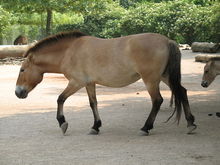According to news reports, five prehistoric-looking Przewalski’s horses, once classed as extinct in the wild, have emerge from the endless plains in the harsh desert steppe of far northwestern China.

Przewalksi's horses making a come-back
Of the 2,000 or so Przewalski’s horses that now exist worldwide, about a quarter are part of efforts to reintroduce them to the wild.
© 2012 by Lars Schmitt
The horses were named after a Russian officer and explorer who spotted them around 18800, and bear a striking resemblance to horses depicted in European cave paintings, with short necks, spiky manes and a yellow hue.
According to the International Union for Conservation of Nature, Przewalski’s horses once roamed as far as Western Europe, but as the centuries passed, climatic change reduced their habitat and the remainder were so widely hunted, mainly for food, that they were classified as extinct in the wild in 1960 – although a living specimen was later found in Mongolia.
A few have survived in European zoos, and now efforts are underway to reintroduce them to the wild.
The Chinese project near Xihu in Gansu province faces daunting challenges – freezing winters, sweltering summers and limited supplies of food and water.
According to Chinese legend, the animals were discovered two millennia ago by an exiled criminal around the oasis of Dunhuang, a crossroads on the Silk Road.
In 1986 China purchased 18 of the horses from the United States, Britain and Germany and has since bred them in captivity, with their numbers growing to more than 70.
Starting in 2010, carefully selected batches have been released into the reserve, and reports show that now there are 27, 16 females and 11 males, including a new foal as of July 2011.
According to Sun Zhicheng, an official at the 660,000-hectare West Lake national nature reserve, very few animals can endure an environment as hard and dry as Gansu’s desert steppes, and Przewalski’s horses require daily access to water that is within a 30-kilometer range and does not freeze in winter. They need 10 kilograms of dry food per day, relatively close to the water.
In a region that receives less than 4 centimeters of rain per year, many of these conditions could become problems, says Sun. The reserve is taking backup measures to improve the horses’ chances. "We have increased the water supply by expanding 10 wells. At a later point we are thinking of bringing water from the river. In winter we have to break the ice so that the horses can drink."
The horses eat grasses and certain plant species, says reserve employee Lu Shengrong, but when vegetation becomes sparse in wintertime, they will be fed dry alfalfa, straw, black beans and corn.
Of the 2,000 or so Przewalski’s horses that now exist worldwide, about a quarter are part of efforts to reintroduce them to the wild, says Claudia Feh, a biologist doing similar work in Mongolia, where several hundred have been released.
The worst threat they face, she says, are ordinary horses, which can infect them with disease or crossbreed with them, diluting the gene pool.
For any wild population to survive long term, or even 50 years, it must be 1,500 strong, Feh says. “That goal is far away,” she adds. “This is a species that is still rather fragile.”
